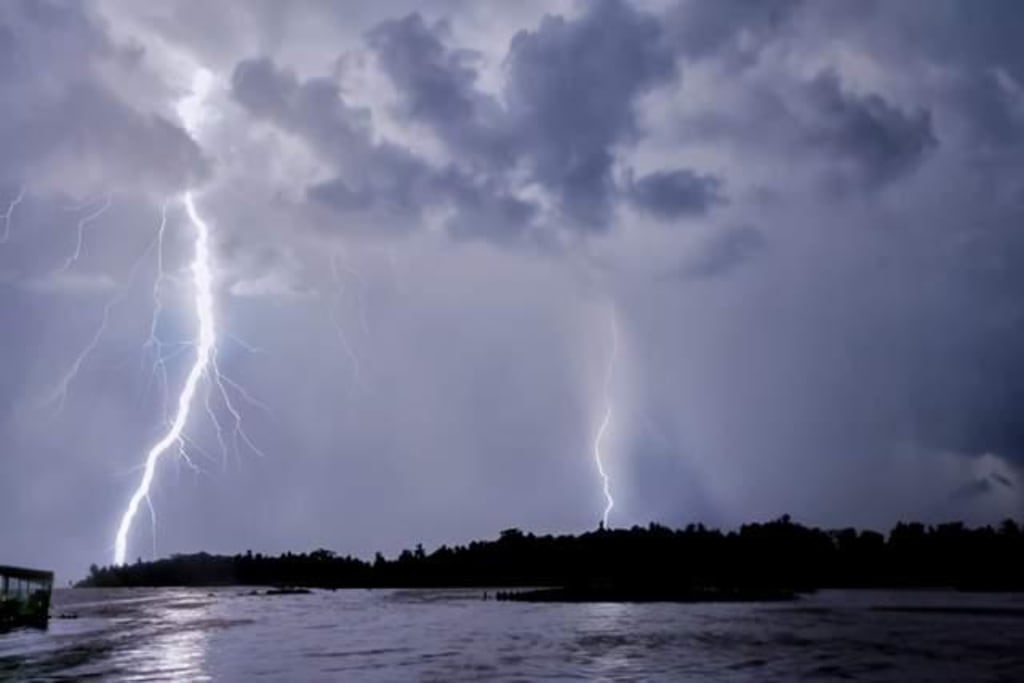A million-year-old storm, 150-year aftershocks, ten record-setting natural events
Ten record-setting natural events

The forces of nature are so great and shocking, some even creepy. Like the fog that killed thousands of people in London. This article will list ten records set by natural phenomena, let's take a look
10. Catatumbo lightning phenomenon
The Catatumbo lightning phenomenon is unique in the world. This phenomenon occurs at the confluence of Lake Maracaibo and the Catatumbo River in Venezuela. This kind of lightning formed by the accumulation of thunderclouds can occur up to 280 times per hour about 140 to 160 nights a year, and the arcs formed by the lightning can reach 5 kilometers long and have an intensity of up to 400,000 amperes, which can be seen The distance is as far as 400 kilometers.
9. The soot stayed for six months
When Australia's fire season finally settles in 2020. The scale and devastation of the bushfires is enormous.
The fire pushed more smoke into the atmosphere than everyone expected. Smoke from Australia's fires traveled from the east coast and returned to the mainland from the west, also bypassing the planet. The whole process took two weeks. This is a record for the smoke and dust from any bushfire.
8. The coldest cloud in the world
Scientists love to measure matter, and they can even measure the temperature of clouds. In 2018, scientists measured intense thunderstorm clouds forming over the Pacific Ocean reaching the lowest temperatures on record. Some of the clouds that belong to the storm cloud even reached minus 167.8 degrees Fahrenheit (111 degrees Celsius).
This extreme number is partly explained by a phenomenon called "overcap." This is when the tops of clouds pass over the lowest layer of the atmosphere and into the next layer, creating a painfully cold field known as the stratosphere.
The Pacific Cloud has an overshooting top. But even the icy nature of the stratosphere couldn't explain why the storm's maximum temperature was 86 degrees Fahrenheit (30 degrees Celsius) cooler than any other cloud on record.
7. The longest aftershock
In 1872, Earthquake shook central Washington state. The epicenter has never been found, and for decades scientists have wondered why Entiat, a town in the region, has been hit by earthquakes following the 1872 quake. Because it was a century long, no one thought it could be hundreds of aftershocks.
But that changed as seismologists began to detect aftershocks around the world that lasted longer than expected. Aftershocks also behave differently from earthquakes, and when researchers collected data from the 1872 quake, they found that subsequent shaking matched aftershocks in nearly every way.
The Entiat phenomenon may be the longest-lasting aftershock in the world. They have been in development for almost 150 years and keep growing.
6. The biggest storm in the world
Typhoon Alert is not a household name. But as the biggest storm in the world, Tip deserves a mention. It was born in the Pacific Ocean and later developed into a super typhoon. With a diameter of 1,380 miles (2,220 kilometers), it was officially the top storm of all. In addition to its record-setting storm size, Tip also set records with unparalleled intensity.
The storm killed nearly 90 people and injured hundreds. The floods caused numerous mudslides and destroyed 20,000 homes. A gas tank also exploded and burned a U.S. Marine Corps base, injuring dozens and killing one.
5. The biggest dust storm in modern times
In 2021, strong winds will dig out the sand in the Gobi Desert and flow through Mongolia. The huge dust storm left 341 people missing and killed at least six. Then, the dust storm reached the Chinese capital. Sandstorms covered skyscrapers, turning the sky orange, and the city of Beijing faded away.
4. Black Sunday
In 1935, a storm gave April 14 an ominous title - Black Sunday.
Black Sunday starts like any other day. But then came the blizzard. It quickly became apparent that this was different and people started to panic. Sandstorm is a 1,000-mile (1,609-mile) long beast. It blocks all light including street lights. Families hiding at home cannot see each other in the same room. Precious arable land was destroyed, many animals died, and one person went blind. People were trapped in their cars for hours.
The aftermath of the storm inspired federal aid. But despite government money and advice, many families gave up farming and left the area.
3. The strongest tornado in history
In 1925, a deadly tornado cluster touched down in the United States. Will bring destruction to a whole new level. Called the "Tri-State Tornado," it tore through 3 states and left the longest track ever created by the twisters - 235 miles (378 kilometers).
The statistics are staggering. The tornado expanded to more than a mile (1.6 kilometers) in diameter and accelerated at 70 miles per hour (113 kilometers per hour). It destroyed 164 square miles (425 square kilometers) of land and destroyed 15,000 homes. By today's estimates, the losses totaled $1.4 billion.
The storm was never classified, but most experts consider the tri-state tornado an EF-5. As far as tornadoes go, the EF-5 is the biggest and most dangerous thing you can hope to see. Regardless of its true rating, the Tri-State tornado remains the deadliest tornado in history. The death toll stands at 695.
2. Killer Fog in London
London is a foggy place. But in 1952, fog covered everyone. The haze emerged in December and lasted for five days, hospitalizing more than 150,000 people.
For decades, the deadly fog remained a mystery. But in 2016, researchers agreed that they had enough evidence to blame one of the earliest suspects in the investigation on burning coal. Tests have shown that air pollution caused by coal emissions causes chemical changes in the weather that end up shrouding the sulphuric acid in the fog.
At the time, the death toll was thought to be 4,000. Sadly, the actual number is closer to 12,000. Thousands of animals were also killed in the fog. It remains the worst air pollution event in European history.
1. Storms that last a million years
The Triassic era ended about 233 million years ago. During this time, raindrops began to fall, causing storms that lasted a million years. This torrent is known as the "Carnian Rain Episode" (CPE).
In 2020, a study found two of the most likely suspects: climate change and volcanic eruptions. Indeed, the eruption was beyond epic. They left behind lava fields that stretched for thousands of miles.
There are many deaths. The downpour kills one-third of all species living in the ocean. At the same time, on land, countless groups of animals and plants also went extinct. But the study also found that CPE created the world we know today. It changed the environment so much that new species emerged, including some of the first coral reefs, reptiles, trees and the dinosaurs that would rule the planet for the next 150 million years.
About the Creator
dardani lennon
The question mark is the key to any science
Enjoyed the story? Support the Creator.
Subscribe for free to receive all their stories in your feed. You could also pledge your support or give them a one-off tip, letting them know you appreciate their work.






Comments
There are no comments for this story
Be the first to respond and start the conversation.